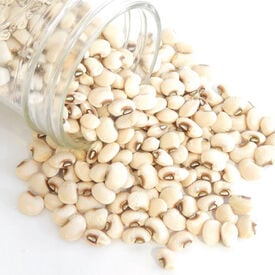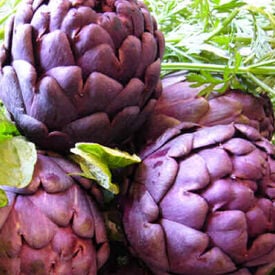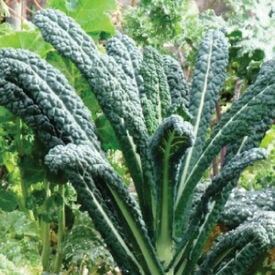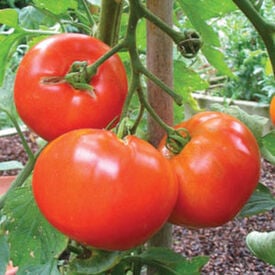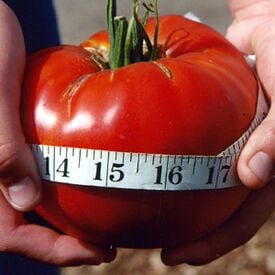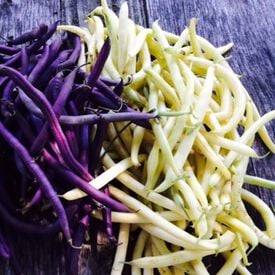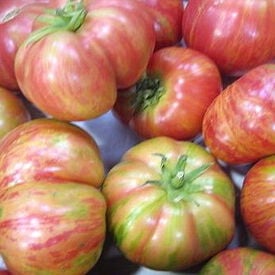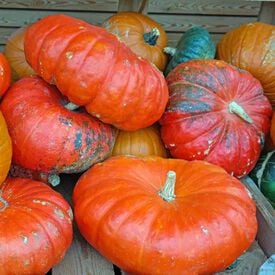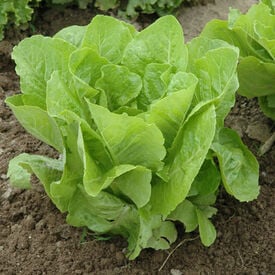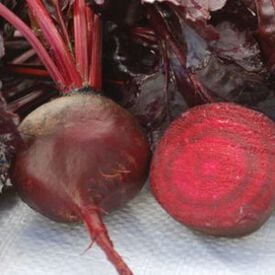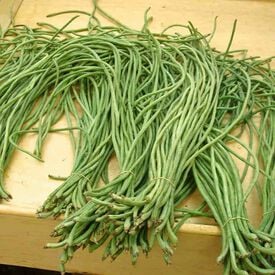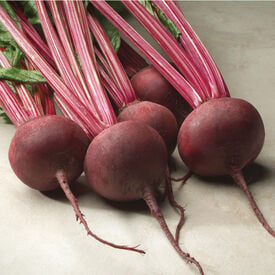The Big Boy Purplehull is a high yielding, popular Southern cowpea that is great for home gardens. Big Boy Purplehull is a long podded variety with 13-16 peas per pod that are light tan in color and oblong shape. This is a good garden variety and is very prolific. If you are using for Nitrogen fixation we highly recommend using a cowpea inoculant. Try with cowpea inoculant for maximum Nitrogen fixation.
Violet is a French heirloom with fine flavor! Beautiful purple buds that are lovely on the big, ornamental plants, especially when the buds open. Rare outside Europe.
Caserta squash is a distinctive heirloom variety of summer squash with a rich history and notable characteristics. Originating from Italy, Caserta squash has been cherished for its unique appearance and exceptional flavor. The squash is characterized by its small to medium size, with a slightly elongated shape and smooth, pale green skin that often has a subtle, mottled pattern. The flesh is tender and creamy, offering a mild, nutty flavor that enhances a variety of dishes, from stir-fries to gratins. Caserta squash typically reaches harvestable maturity in about 50 to 60 days from planting, and the plants exhibit a bushy, compact growth habit, making them well-suited for smaller garden spaces. They thrive in warm, well-drained soil and prefer full sun exposure. The plants are prolific producers, yielding an abundance of tender, flavorful squash throughout the growing season. With its unique color, mild flavor, and manageable growth habits, Caserta squash is a valuable addition to both culinary gardens and farm-to-table dining experiences. The Caserta Zucchini is an early bush cocozelle that was a 1949 AAS winner.
Lacinato kale, also known as dinosaur kale or Tuscan kale, is a leafy green vegetable characterized by its long, dark green, crinkled leaves. The leaves have a distinctive bumpy texture and are often a deep, rich shade of green, sometimes with a bluish tint. They grow on tall, upright stalks and have a slightly sweeter and milder flavor compared to other kale varieties. This type of kale is prized for its versatility in the kitchen. It can be eaten raw in salads, blended into smoothies, sautéed, or added to soups and stews. Lacinato kale holds up well to cooking without losing its texture, making it a favorite for both chefs and home cooks alike. Nutritionally, it's packed with vitamins A, C, and K, as well as minerals like calcium and iron, making it a powerhouse of health benefits. Its striking appearance and robust flavor make Lacinato kale a standout choice for any dish!
Reid's Yellow Dent Field corn is a traditional American heirloom variety known for its high yield, excellent versatility, and resilience. Originally developed in the 19th century, this corn was once a staple in Midwestern farming due to its ability to thrive in a range of soil types and climates. The kernels are large, golden-yellow, and dented, which is characteristic of field corn varieties. Reid’s Yellow Dent is primarily grown for its use in animal feed, as well as for grinding into cornmeal, flour, and masa for making tortillas, cornbread, and other baked goods. It's also popular for producing hominy and grits, and historically, it played a significant role in the production of corn syrup and ethanol. What makes Reid's Yellow Dent particularly valuable is its resilience in the field, with a high tolerance for drought and disease. This heirloom variety is open-pollinated, making it an excellent choice for sustainable farming and seed-saving. It has a robust history in agricultural development and remains a beloved variety for both small-scale and commercial farmers looking to grow an adaptable, productive crop with a deep connection to agricultural traditions.
Alaska pea seeds grow into one of the oldest and earliest-maturing pea varieties, first introduced in the late 1800s and valued for its ability to thrive in cool northern climates. This hardy shelling pea produces compact, vining plants that yield an abundance of small, smooth, bright green pods filled with sweet, tender peas in just about 55 days, making it a favorite for short-season gardeners. The plants are relatively easy to grow, preferring well-drained soil and cool weather, and they often set pods before summer heat diminishes yields. With a mild, slightly starchy sweetness, Alaska peas are excellent for fresh eating, freezing, or canning, and have long been popular in soups and stews due to their ability to hold flavor and texture after cooking. Their dependable growth and versatile use have kept them a staple in gardens for well over a century.
The Bradley Tomato is one of the all time Southern favorites! This tomato variety is a reliable, productive plant that has fairly good cover, producing attractive, smooth pink fruit with a tasty mild flavor. Bradley is a disease resistant variety released in 1961 by Dr. Joe McFerran of the University of Arkansas. The seeds produce delicious, sweet tomatoes that are well balanced with just enough acidity to give you that old-fashioned big tomato flavor that you love so much. Bradley tomatoes ripen at the same time making it a great variety for canning and freezing. This variety is suitable for Southern regions, but can grow in most places.
The Delicious Tomato is a World Record giant, bright red beefsteak tomato that can grow to be at least one pound or more. This variety is not only large, but it is also fairly crack resistant. The Delicious tomato gets its name for being very delicious of course!
The fine smooth texture of the Nantes carrot makes it perfect for fresh eating, freezing or juicing! This bright orange carrot is a garden favorite. Nantes has an excellent sweet flavor as an early baby carrot. It can be over-wintered or grown in high tunnels for a spring harvest. Certified Organic. Learn more about our organic seeds.
The Mardi Gras Blend is almost too pretty to eat! These fun bright yellow and purple semi flat bean pods are a favorite among home chefs. The Mardi Gras Blend sets a heavy crop of delicious nutty beans. These organic heirlooms are a fun way to get beneficial nutrients.
The Vintage Wine Tomato is a favorite tomato among gourmet gardeners! This is a wonderful tomato plant to add to your garden as it grows large tomatoes that can reach 1.5 lbs. This variety produces big pink colored tomatoes with golden stripes that have a great tender, sweet and mild flavor. The Vintage Wine plant has potato leave foliage.
The Fancy Nantes carrot gets its name for its very smooth skin and fancy cylindrical shape. These carrots can grow up to 8" long with a very sweet and crisp flesh. For smaller, "fancier" look and great flavor try harvesting at 45-50 days when 4" long! They can store for months and also do great being left in the ground over winter.
The Cinderella is an excellent pumpkin for canning or baking pies and pumpkin bread as it has a great eating quality! This pumpkin variety is an heirloom variety from France that was selected out of the older variety, Rouge vif d'Etampes. Cinderella has deep ridges and exceptional flatening, making it a beautiful decoration for Halloween and other other fall festivities. This variety's vines are very productive with pumpkins that have grooved, thick walls.
The Jericho Lettuce is known for its great baby leaf production and is very tolerant to hot weather. This lettuce is a blonde romaine that can be grown for both baby leaf and full-size heads. This lettuce variety is very attractive with its bright light-green leaves. Jericho is tolerant to both heat and tipburn. Certified Organic. Learn more about our organic seeds.
A great pumpkin for compact growing and Powder Mildew is a concern. Magic Lantern’s produces classic size pumpkins in the 16-24 lb. range with bright orange skins and attractive medium ribs. Growers note good crown set on Magic Lantern’s vines, as well as higher yield per acre from closer planting.
Bull's Blood beet, scientifically known as Beta vulgaris, is a striking and versatile variety of beetroot that has gained popularity for its unique characteristics. This heirloom variety has a fascinating history, dating back centuries to Europe, where it was initially cultivated for its edible leaves rather than the root. Its name, "Bull's Blood," is derived from the deep burgundy-red color of its leaves, which resemble the color of ox blood. Over time, its sweet and earthy flavor profile has made it a favorite among chefs and home gardeners alike. In terms of appearance, Bull's Blood beets typically grow to a medium size, roughly 2-3 inches in diameter, and have a round to slightly flattened shape. The seeds of this variety are easy to come by and can be sown directly in the garden or started indoors. Bull's Blood beets are relatively quick to mature, taking about 50-60 days from seed to harvest. The leaves are a deep red, while the root itself is a dark purplish-red, making it visually appealing on the plate. Bull's Blood beets exhibit some resistance to common beet diseases like Cercospora leaf spot and Downy Mildew, although specific resistance levels may vary depending on growing conditions. When properly cared for, they can yield a plentiful harvest. To ensure optimal growth, it's recommended to space the beet plants about 2-4 inches apart in well-drained soil with full sun exposure. Adequate moisture and consistent watering are essential for healthy growth. Whether you're looking to add a pop of color to your garden or enhance your culinary creations, Bull's Blood beets are a delightful choice with a rich history and vibrant character.
A beautifully bright and vibrant green bean that grows extra long when mature! Matures quick and has a delicious and crisp bite.
Red Ace Beet seeds produce one of the most reliable and widely grown hybrid beet varieties, developed in the 1970s for uniformity, earliness, and adaptability. Known for their smooth, globe-shaped roots with vibrant red flesh and minimal zoning, Red Ace beets mature quickly—often in just 50 days—making them a favorite for both home gardeners and market growers. The tops are tender and flavorful, doubling as nutritious greens, while the roots offer a sweet, earthy taste that remains consistent even when grown in varying climates. Easy to cultivate, they thrive in full sun and well-drained, loose soil, with regular watering encouraging optimal growth. Their excellent disease resistance, high yields, and ability to hold sweetness even when larger make them an ideal choice for fresh eating, roasting, pickling, or juicing.
